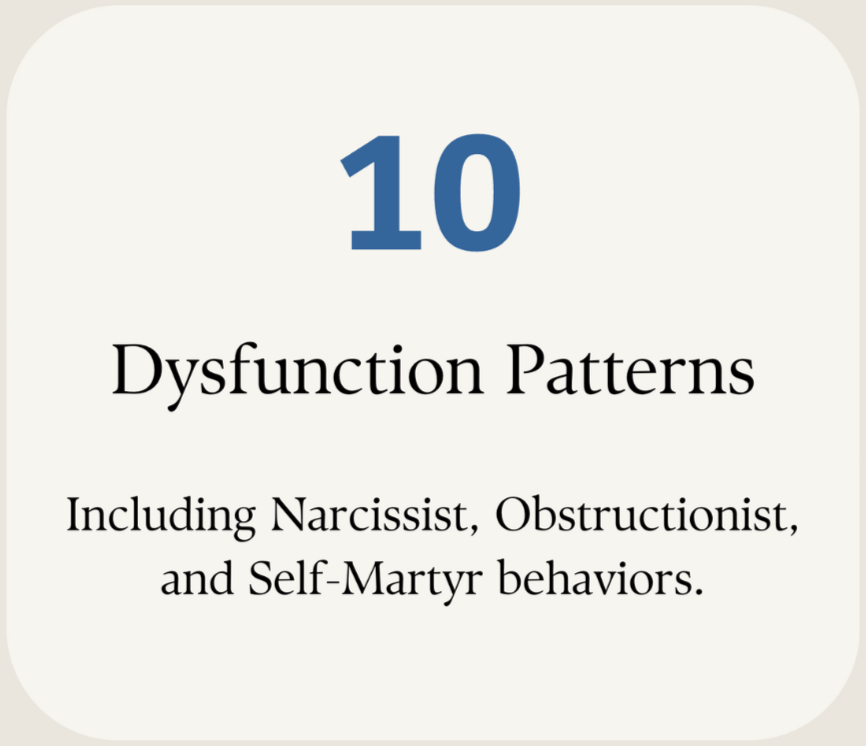The only CEO intelligence that connects human decisions to outcome.
Stealth Dog LabsAs CEO, you're the only person who has to manage leadership trade-offs.
Ideally, you're making decisions based on your entire ecosystem of vendors, customers, employees, and competitors in all three states of past, present, and future.
You win if you find the causality that is driving future financial states. You really win if you remove the 50%+ noise in the system that does nothing to drive your future.
What if there was a system to predict the consequences of your decisions long before the backwash of financials has you walking into a boardroom on your heels?
It exists.

We measure the invisible human variables that are causal to business outcomes.
Within hours, we can show you the psychological architecture behind your P&L and give you predictive intelligence on your entire business ecosystem.
Why is this important?
Because human metrics predict financial outcomes 6-18 months ahead of traditional financial indicators, providing unprecedented competitive advantage through early insight and intervention capabilities.
THE CEO PROBLEM?
Managing on intuition without data.
You’re forced to rely on gut feelings.
Your most critical decisions are based on intuition and experience because the causal data simply doesn’t exist in your current systems.
Noise distorts the clear path to signal.
A relentless pursuit of signal yields the path to causality; but if signal stays hidden, you make choices based on vague feelings and uncertainty rather than clear data.
Financial models are backward looking.
What has happened does not drive what happens next. You’re steering using the rearview mirror while the road ahead remains invisible and winding.
High-stakes decisions in the dark.
Without “radar” intelligence of your ecosystem, you can’t predict which team will execute, which vendor will scale, or which customers will buy.
Our Solution?
Remote psychological radar for business performance.
We’ve analyzed 1.3 million businesses and tens of millions of individuals to create the only technology that measures psychological causality remotely—giving you predictive intelligence on human performance across your entire ecosystem.
The Complete Ecosystem Matrix
We provide unprecedented intelligence across all of your key stakeholders across time.
We remotely measure the psychological architecture behind business performance using only public language data.
Key Advantages to This System
Speed
We can compute the causal variables of customers, vendors, employees and competitors to provide a remote view of your ecosystem. That means you get solutions to problems in weeks, if not days.
Proven Science
Our technology is based on 150+ year old science that only recently could be scaled. Similar methods are used by the largest companies in the world for hiring, planning, and relentless growth.
Predictive Accuracy
Human thinking patterns predict business outcomes months before they appear as financial metrics, giving you unprecedented strategic advantage.
Undetectable
Similar to sonar and radar but for human performance, we detect human thinking patterns from public communications without surveys or internal access. We can then connect that language back to your company’s outcome, results, reviews, financial data and future.
Decision Capability Assessment
We create clear choices based on your top priorities that are not getting solved using older methods.
Signal-to-Noise Optimization
Focus only on people data that predict business outcomes. Eliminate the noise of irrelevant metrics that don't drive results.
How It Works
From Language to Leverage
Proof Points
Validated results based on analysis of 1.3 million businesses and real-world case studies from our founder’s 25-year track record.
McKinsey Research
Beyond Performance 2.0: Companies that align people models with business models outperform by 2.9x in ROIC. Our technology operationalizes this research at a speed and scale never before possible.
Free Cash Flow Improvement
20% FCF lift: When vendor and team psychological alignment is optimized, companies see measurable improvement in cash conversion and operational efficiency.
Stock Price Prediction
Leadership psychology predicts stock direction: Your public statements give up how confident you are of the future, sometimes six to 18 months in advance. Analysts perceive it, and so should you.
Transformation Success Rate
60-80% initiative success: By measuring psychological readiness before strategy launch, we help companies achieve success rates far above industry average.
Our Founder’s Track Record
Christopher Skinner has 25 years of experience leading change and growth across 7 companies in 4 industries, with deep expertise in:
Business model transformation and scaling, national security development and dual-use transitions, predictive systems for leadership evaluation and investor trust restoration, 15 years in search algorithms, marketing technology, and econometrics. What happens when you combine digital psychology with radar, all built by an abstract mathematician? Stealth Dog Labs.
Our founder, Christopher Skinner, speaking at Google Partners Brussels.
Ready to Transform Intuition into Intelligence?
Within hours, we can show you the psychological architecture behind your P&L and give you predictive intelligence on your entire business ecosystem.
No surveys. No interviews. No disruption.
Just the missing intelligence you need to make confident decisions.








